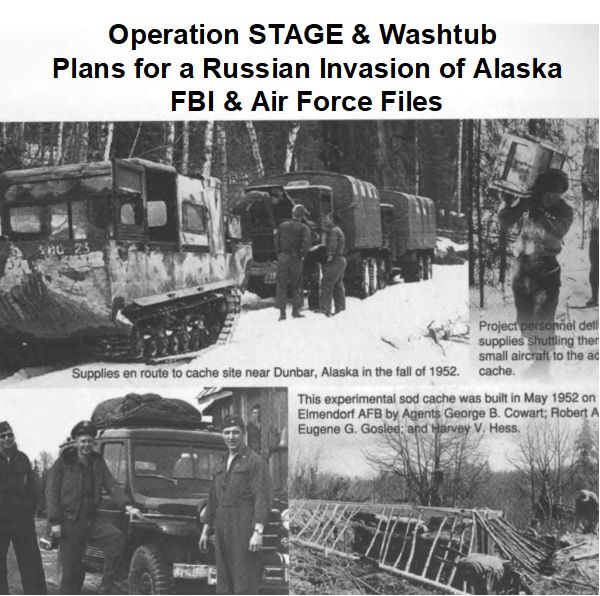
Operation STAGE & Washtub Plans for a Russian Invasion of Alaska FBI & Air Force Files
$19.50
Description
Alaska’s Secret Cold War Agents
- June 20, 1950: An FBI memo indicates that the Interdepartmental Intelligence Conference is considering a plan to develop individuals who could act as agents for the United States if Alaska were occupied by a foreign power. This marks the initiation of what would become the “Alaska Project.”
- 1950-1951: The FBI, through its “Operation STAGE,” and the Air Force’s Office of Special Investigations (OSI), through “Operation Washtub,” form a joint venture to identify and train “Stay Behind Agents” (SBAs) in Alaska. The newly established CIA is intentionally excluded from this planning.
- September 1951: The FBI abruptly ends its involvement in the “Alaska Project” (Operation STAGE). The specific reason for their withdrawal is not indicated in the released materials, though internal memos suggest a reluctance to participate in a largely military intelligence program that did not align with the FBI’s culture of working alone.
- Post-September 1951 – 1959: The Air Force’s Operation Washtub continues to operate independently, managing the “Alaska Project.”
- Undated (During Project Operation): Criteria for selecting SBAs are established. Civilians are prioritized, with examples including a one-armed professional photographer, amateur radio operator, hunting/fishing guide, survival expert, and small aircraft pilot.
- Undated (During Project Operation): Both the FBI and Air Force documents explicitly advise against recruiting indigenous Alaskans (Eskimos, Indians, Aleuts) as agents, citing perceived unreliability, propensity for excessive drinking, and fundamental indifference to established governments.
- Undated (During Project Operation): Out of Alaska’s population of approximately 135,000, an initial list of 40,000 possible agents is compiled. This list is subsequently narrowed down to 89 potential SBAs.
- 1959: When Alaska is granted statehood, the “Alaska Project,” then solely under the control of the Air Force, is officially ended.
Cast of Characters
The sources primarily refer to agencies and types of individuals rather than specific named people. Therefore, the “cast of characters” is generalized based on the roles and groups described.
- The Federal Bureau of Investigation (FBI): A primary U.S. government intelligence and law enforcement agency involved in the initial planning and implementation of “Operation STAGE.” They sought to prevent the CIA from gaining intelligence influence in Alaska and eventually withdrew due to a perceived mismatch with their operational culture.
- The Air Force’s Office of Special Investigations (OSI): The Air Force agency responsible for “Operation Washtub,” which formed a joint venture with the FBI for the “Alaska Project.” They continued to manage the project after the FBI’s withdrawal until Alaska achieved statehood.
- Interdepartmental Intelligence Conference: A coordinating body mentioned as considering the initial plan for developing agents in Alaska.
- Civilians (Potential Stay Behind Agents – SBAs): The target demographic for recruitment as clandestine agents in the event of a Soviet invasion. They were sought for specific skills like photography, radio operation, guiding, survival, and piloting small aircraft. An example given is a one-armed professional photographer in Anchorage.
- Indigenous Alaskans (Eskimos, Indians, Aleuts): Groups explicitly excluded from consideration as Stay Behind Agents by both the FBI and Air Force due to perceived “basic unreliability,” “propensities to drink to excess,” and “fundamental indifference to constituted governments and political philosophies.”
- The Central Intelligence Agency (CIA): A newly established U.S. intelligence agency intentionally excluded from the “Alaska Project” planning by the FBI and Air Force to prevent its involvement in intelligence operations in Alaska.
Operation STAGE & Washtub Plans for a Russian Invasion of Alaska FBI & Air Force Files
3,271 pages, 2,126 FBI and 1,145 Air Force pages of documents dating from 1950 to 1959, covering proposed plans for intelligence coverage and stay behind agents in Alaska in the event of an invasion by the Soviet Union.
Four and a half years after the end of World War II and nine years years before Alaska became the 49th state in the Union, the FBI and the United States military began a plan to have stan behind agents in Alaska in case of a Soviet takeover of the American territory. During World War II, Japan occupied part of Alaska for approximately 14 months.
A June 20, 1950, FBI memo states, “The Interdepartmental Intelligence Conference is considering a plan for the development of individuals who could act as agents for the United States in the event that Alaska is occupied by a foreign power.” The FBI’s Operation STAGE and the Air Force’s Office of Special Investigations’ Operation Washtub formed the joint venture which eventually became known as the “Alaska Project.”
Between 1950 and 1951, the FBI was involved in planning for and beginning to implement a program to identify and train personnel who would act in a clandestine capacity in Alaska should the USSR invade. This Stay Behind Agent Program, called STAGE by the FBI, was to be done in concert with other government agencies. The FBI abruptly ended its involvement in September of 1951; the reason why is not indicated precisely in the materials so far released. The Air Force’s Operation Washtub continued to operate until 1959.
The memos show that the newly established CIA was intentionally left out of the planning. One FBI memo states, “The principal advantage to the FBI’s assuming joint responsibility in these two programs is that it will preclude any other intelligence agency, such as the CIA, getting into the intelligence field in Alaska at this time.”
The agencies decided it would recruit from the civilian population to find Stay Behind Agents or SBAs. The reason for this is demonstrated in an Air Force memo titled, “Proposals Implementing the Prosed Plan for Intelligence Coverage in Alaska.” It states:
“An example of a typical person to be one of the principals is a professional photographer in Anchorage; he has only one arm and it is felt that he would not benefit the enemy in any labor battalion; he is an amateur radio operator; he is a professional photographer; he is licensed as a hunting or fishing guide, and well versed in the art of survival; he is a pilot of a small aircraft; he is reasonably intelligent, particularly crafty, and possessed of sufficient physical courage as is indicated by his offer to guide a party which was to have hunted Kodiak bear armed only with bow and arrow. If such an individual were chosen it is believed that he would be eminently satisfactory as a principal.”
Both the FBI and Air Force documents dissuade the use of indigenous Alaskans as agents. One FBI memo states, “Selection of agents from the native groups, Eskimos, Indians, Aleuts, should be avoided because of their basic unreliability.”
An Air Force memo goes deeper into ethnic stereotypes stating, “The selection of agents from the Eskimo, Indian, and Aleut groups in the Territory should be avoided in view of their propensities to drink to excess and their fundamental indifference to constituted governments and political philosophies. It is noted that their prime concern, is with survival and their allegiance would easily shift to any power in control.”
This despite that the use of indigenous North Americans in World War II has been cited as being highly successful.
Out of Alaska’s population of about 135,000, the initial list of possible agents was 40,000. This was cut down to the point that 89 potential SBAs were selected.
The FBI became concerned about being involved in a program that was largely military intelligence. Working with other agencies did not match the Bureaus’ culture of working alone. One FBI memo states, “So, why should the FBI get involved in such a scheme where there is largely all brunt and no credit.”
When Alaska was granted statehood in 1959 the Alaska Project, then under control of the Air Force, was ended.
Related products
-
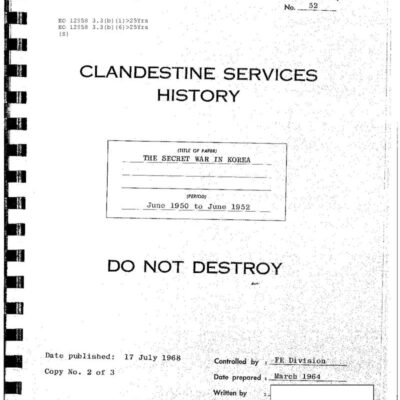
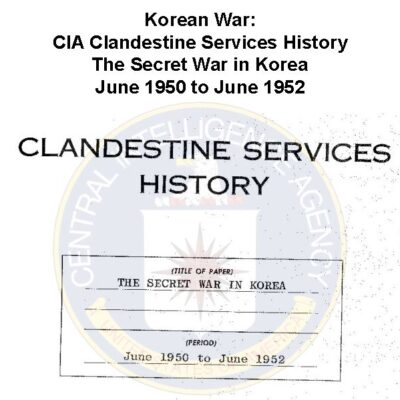
Korean War: CIA Covert Operations History – The Secret Conflict in Korea
$3.94 Add to Cart -


Operation POPEYE in the Vietnam War
$5.94 Add to Cart -

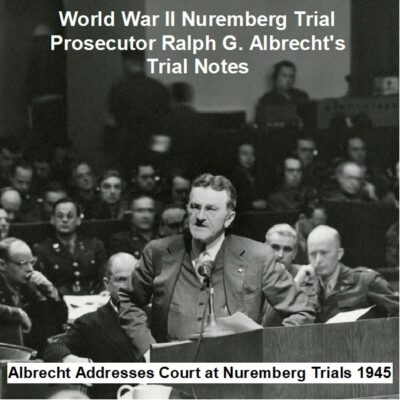
Trial Notes of Ralph G. Albrecht, Prosecutor at the Nuremberg Trials of World War II
$3.94 Add to Cart -
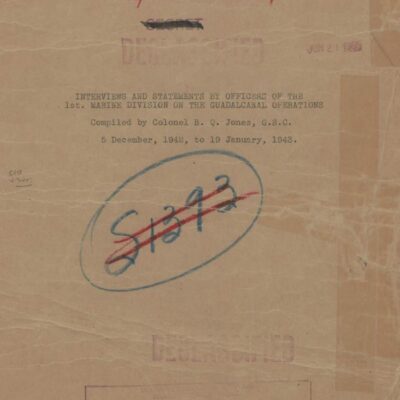
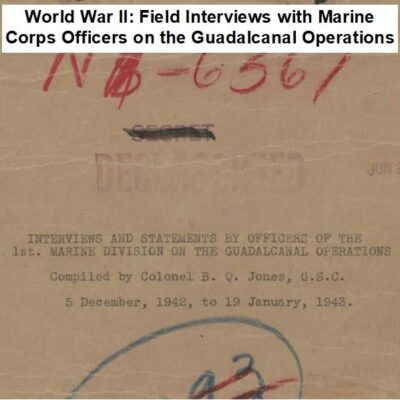
World War II: Marine Corps Officer Interviews on Guadalcanal Operations
$3.94 Add to Cart